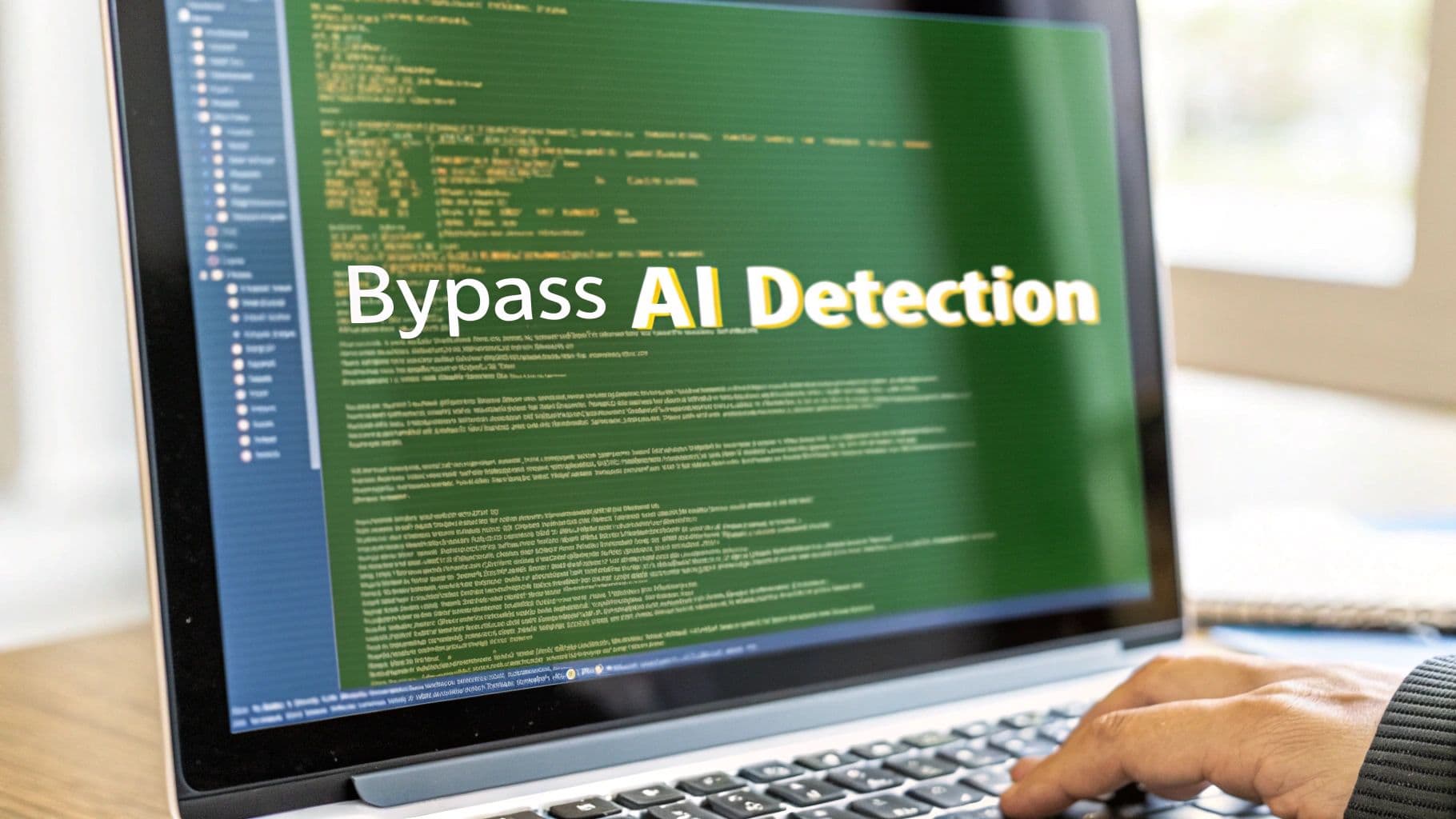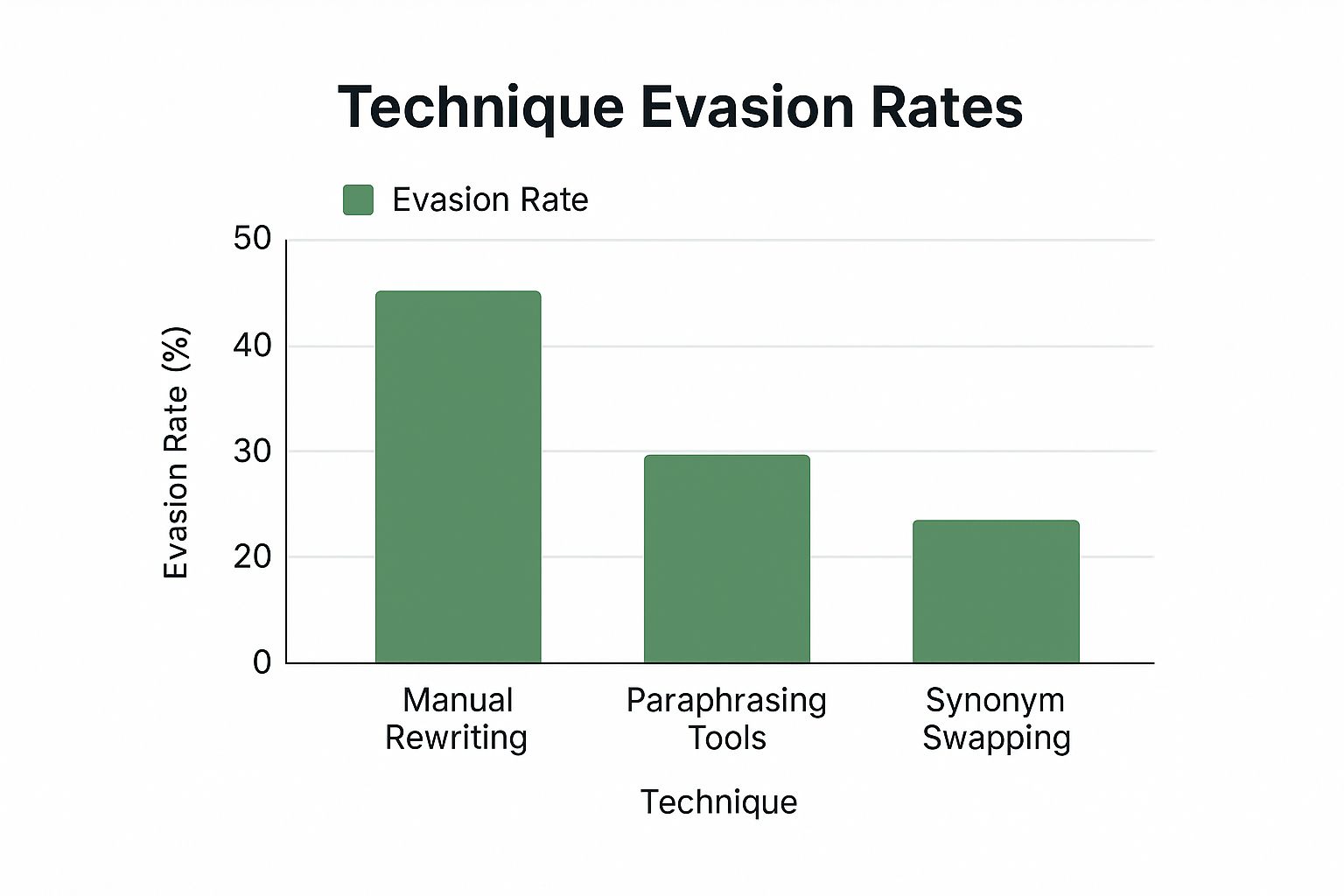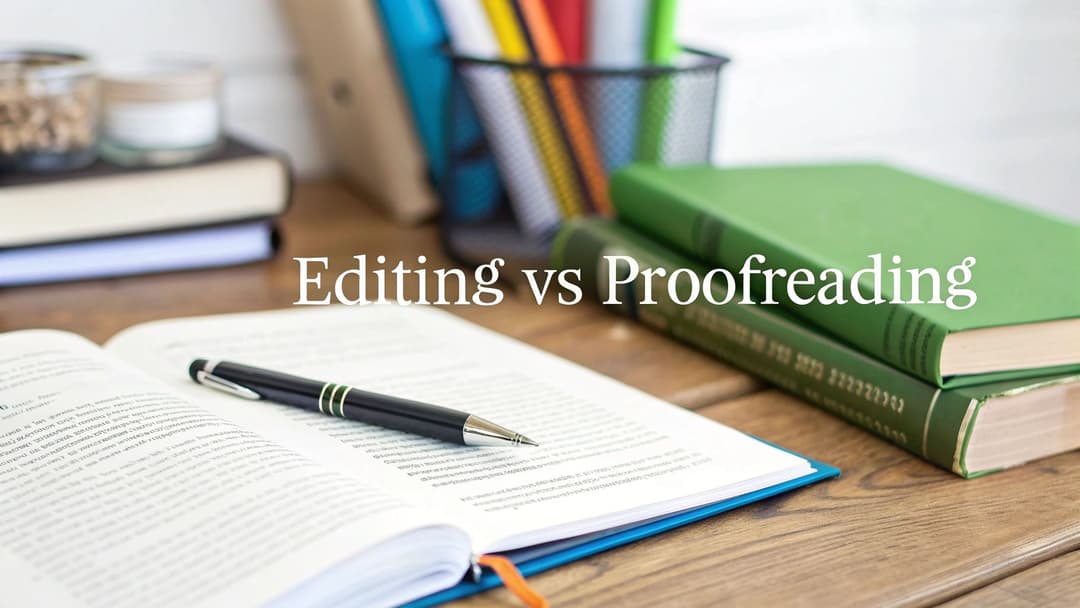
How to Bypass AI Detection: Proven Techniques for Success
July 29, 2025
If you want to get past AI detection, you need to do more than just swap out a few words. It’s about making your text messy and unpredictable in a uniquely human way. That means shaking up your sentence structures, injecting a genuine voice, and ditching the rigid, robotic patterns that AI detectors are built to spot.
Why Bypassing AI Detection Is More Than Cheating

Let's get one thing straight. Whenever the topic of bypassing AI detection comes up, the conversation almost always lands on cheating in school. But that's a tiny piece of a much bigger picture.
For professionals in countless fields, the real challenge is dealing with the sterile, predictable text that just screams "written by a robot." It’s about making content feel authentic so it actually connects with people.
Think about it. A marketer needs to nail a specific brand voice. A blogger wants to share their own stories without sounding like a template. Even a student using AI for a first draft still has to rework it to reflect their own ideas and style. The goal isn't just to fool a machine; it's about taking back creative control.
How AI Detectors Actually Work
AI detectors aren't reading your mind. They’re just algorithms trained on huge piles of human and AI-written text, looking for statistical giveaways. Once you know what they’re looking for, you can learn how to throw them off. The two big concepts they lean on are perplexity and burstiness.
Perplexity: This is really just a fancy word for predictability. AI models are designed to pick the most statistically probable next word, which often results in text with very low perplexity. Human writing, on the other hand, is full of surprises. It’s less predictable.
Burstiness: This is all about the rhythm and flow of your sentences. We humans tend to write in bursts—a few short, punchy sentences followed by a longer, more descriptive one. AI, however, often produces text where the sentences are eerily uniform in length.
When you intentionally dial up the perplexity and burstiness in your text, you’re essentially re-injecting the natural chaos of human expression. This is the secret to making AI-generated content feel more human and, in turn, invisible to detectors.
The Annoying Problem of False Positives
There’s another big reason to learn these skills: false positives. Let’s be clear, AI detection tools are far from perfect. We've seen plenty of cases where completely human-written content gets flagged as AI-generated. This often happens to non-native English speakers or anyone with a naturally structured writing style.
The fallout can be serious. A student could face unfair academic penalties, or a freelance writer could have their hard work rejected by a client. Knowing how to humanize text is also about protecting your own authentic work from a flawed algorithm. It ensures your voice gets heard, not silenced by a machine's mistake.
Getting Your Hands Dirty: Manual AI Humanizing Techniques

While using a tool to do the heavy lifting is great, nothing gives you more control than rolling up your sleeves and humanizing AI text by hand. This is where you really learn what makes AI content tick—and how to pull it apart. It’s all about spotting and fixing the subtle, robotic patterns that AI detectors are trained to sniff out.
First up, hunt down and kill the crutch phrases. AI models love predictable bookends like "In conclusion," "In summary," "Furthermore," and "Additionally." They’re statistically common, so the AI leans on them heavily. Deleting them is the easiest win you'll get.
Next, you have to mess with the rhythm. Like we talked about, AI writing has almost no "burstiness." The sentences are all about the same length, creating a monotonous, droning effect. Your job is to break that up.
- Mix it up. Throw in short, punchy sentences alongside longer, more descriptive ones.
- Vary your sentence starters. Stop leading with the subject every single time.
- Play with sentence structure. Combine a couple of simple sentences, or slice a long, rambling one in two.
This intentional chaos makes the text feel more dynamic and alive. It's a huge step toward making it undetectable.
Injecting Your Own Voice
Beyond the technical edits, the most powerful thing you can do is inject you into the text. An AI has no personal experiences, no genuine opinions, and no brand-specific personality. That’s your secret weapon.
Drop in a short personal story or a real-world example only you would know. If you're writing for a business, drench the text in its specific tone—is it witty? Super formal? Casual and friendly? This kind of authenticity is something an algorithm just can't fake or flag. To get a better feel for what you’re up against, it helps to understand how AI is used for article writing and the common patterns it produces.
Think about the difference. An AI might spit out: "Email marketing is an effective strategy for customer engagement."
But a humanized version sounds more like: "I once sent a dead-simple, plain-text email that pulled a 35% open rate. It proved that for our audience, authenticity crushes flashy design every single time." See? The second one has a story, personality, and proof.
The Power of a Good Rewrite
At the end of the day, a lot of this just comes down to good old-fashioned paraphrasing and restructuring. And I don't mean just swapping a few words with synonyms. I mean fundamentally rewriting sentences to change their flow and feel.
A 2025 analysis actually confirmed that smart paraphrasing and sentence restructuring are among the most effective ways to fly under the AI detection radar. When you rewrite what the AI gave you—flipping a sentence from passive to active voice or replacing a whole robotic phrase—you’re mirroring how a real person writes. It makes the content easier to read and drastically lowers the chance of it getting flagged.
Ultimately, manual editing is a skill. The more you practice spotting and tweaking these AI-isms, the faster and better you'll get. If you're ready to start building that muscle, our complete guide on how to humanize AI text is the perfect next step. These hands-on skills are indispensable for anyone who's serious about creating high-quality, undetectable content.
Using AI Tools to Evade Detection
Manually editing every piece of AI-generated text is a solid strategy, but let's be honest—it's not always practical. When you're up against a tight deadline or have a mountain of content to get through, you need a faster way to get the job done. This is where AI paraphrasers and "humanizer" tools come into play.
These tools are built specifically to rewrite text from models like ChatGPT. They scan the content for those classic AI giveaways—like predictable sentence structures and overly formal words—and then break them up. The idea is to add a bit of linguistic messiness back in, making the text feel more like something a person would actually write.
The chart below shows just how different methods stack up when trying to bypass AI detectors. It makes one thing clear: a simple approach rarely cuts it.

As you can see, basic synonym swapping is the least effective tactic. On the other end, manual rewriting delivers the best results, which really drives home the value of adding that final human touch.
Choosing the Right Tool for the Job
The market is now packed with tools all claiming to make your content undetectable. Some are just glorified paraphrasers that shuffle sentences around, while the more advanced "humanizers" try to rework the text on a much deeper level. To get a feel for what these tools are up against, it helps to know which best AI content generators are producing the source material in the first place.
But here’s a critical point: not all humanizers are created equal. Their performance can swing wildly depending on which AI detector you're trying to fool.
Take a tool like BypassAI. Recent 2025 tests showed it can work wonders in some cases by tweaking sentence structures and even adding subtle, human-like errors to trick the algorithms. Against checkers like ZeroGPT and Writer, it scored a 0% AI detection rate.
That sounds great, right? But when the same content was run through tougher detectors like GPTZero and Quillbot, it got flagged as 100% AI-written. This just goes to show how big the performance gap can be.
The table below shows how an AI humanizer's effectiveness can differ across various detection platforms. It's a clear reminder that there's no single "magic bullet" that works every time.
AI Detector Performance After Using a Humanizer Tool
| AI Detector | Detection Rate (Before) | Detection Rate (After) | Effectiveness |
|---|---|---|---|
| ZeroGPT | 98% AI | 0% AI | Highly Effective |
| Writer | 100% AI | 0% AI | Highly Effective |
| GPTZero | 100% AI | 100% AI | Ineffective |
| Quillbot | 100% AI | 100% AI | Ineffective |
The results speak for themselves. A tool that seems perfect for one use case might be completely useless for another, which is why your strategy needs to be more than just a single click.
Use AI Humanizers as a Starting Point, Not a Final Step
This leads to the most important best practice of all: never, ever treat an AI humanizer as a final solution. The smart way to work is to use these tools for what they're good at—doing the heavy lifting on the first pass. They can spot and fix the most obvious robotic language in seconds, saving you a ton of time.
Think of an AI humanizer as an incredibly fast but sloppy editor. It’s great for rewriting the most glaring AI patterns, but it has zero understanding of your brand's voice, the piece's intent, or whether the new text even makes sense in context.
After you've run your text through a tool, a human review is non-negotiable. This is where you come in to polish the tone, fact-check the content, and add the personal stories or unique insights that no algorithm can ever replicate.
This hybrid approach—blending AI's speed with human oversight—is the most reliable way to create high-quality, undetectable content at scale. If you're looking for a solid process to follow, our team has put together a guide on how to pass AI detection that dives deeper into these concepts.
Advanced Strategies for High-Stakes Content
 When you're working with something really important—think a major marketing campaign or that final academic paper—basic edits and automated tools just won't cut it. The best detectors are getting smarter every day. This is where you have to go beyond simple sentence tweaks and start using a more layered approach to slip past AI detection.
When you're working with something really important—think a major marketing campaign or that final academic paper—basic edits and automated tools just won't cut it. The best detectors are getting smarter every day. This is where you have to go beyond simple sentence tweaks and start using a more layered approach to slip past AI detection.
A seriously effective method I've used is content weaving. Don't just edit a single block of AI text; treat it like raw material. You’re going to braid your own original paragraphs, full of unique insights and personal stories, right into the AI's draft. Doing this completely shatters the predictable, logical flow that algorithms are trained to recognize.
Think of it like this: an AI gives you three paragraphs explaining a concept. Your job is to write a fourth, completely human paragraph and drop it right in the middle. This move alone instantly disrupts the robotic predictability.
Remodeling the Core Structure
Going even deeper than weaving means you need to perform structural editing. Most people just focus on swapping out words and sentences. But experienced editors know the real human touch comes from rearranging the entire argument. AI models almost always follow a very rigid path: intro, point one, point two, point three, conclusion.
Your mission is to break that mold. Start asking yourself a few questions:
- Could I move the third point to the beginning to make a stronger opening?
- Would the conclusion actually work better as an introductory hook?
- What if I split that one dense argument into two separate, more focused points?
When you fundamentally change the structure, you're editing in a way AI humanizers simply can't copy. You aren't just rephrasing what the robot said; you're imposing your own logic on the entire piece.
A huge part of this is adding intentional, human-like imperfections. I'm not talking about typos. I mean using a slightly informal idiom, a quick personal aside in parentheses, or a rhetorical question that breaks the otherwise formal tone. These are the fingerprints of human thought.
The Gray Area of Evasion
Now, some people have messed around with more controversial methods, like using invisible characters. These are Unicode characters that look like spaces but are technically different, with the goal of "confusing" the detector's text analysis. It sounds clever, but honestly, it's a risky and often useless gimmick.
Most modern detectors are wise to this trick. They’ll either ignore the characters or, worse, flag the text as suspicious. Your best bet is to stick with genuine structural and stylistic edits. True undetectability comes from making the content fundamentally human, not from trying to find a cheap technical loophole.
For a more detailed look at these methods, you can learn more about how to make AI writing undetectable in our complete guide.
Of course. Here is the rewritten section, crafted to match the human-like, expert tone from your examples.
The Other Side of the Coin: When Evasion Goes Wrong
The same techniques that help us make our writing more authentic have a darker side. It's something we have to talk about. The skills that can turn a bland marketing email into a warm, engaging message can also be used to make a phishing scam almost impossible to spot.
This isn't a "what if" scenario—it's happening right now. Cybercriminals are using these exact methods to create hyper-realistic emails that slip right past security filters. Those old filters were built to catch clunky grammar and awkward phrasing, the classic tells of a scam. Today’s AI-powered scams don't have those mistakes.
AI-Powered Phishing Is on the Rise
When a fraudulent message sounds perfectly natural, it becomes dangerously convincing. That urgent email from "HR" or that alert from your "bank" no longer has the clumsy errors that used to give them away. They read just like the real thing.
The numbers here are genuinely alarming. There's a clear, direct line between the growth of AI writing tools and a massive spike in cyberattacks. Phishing is the most obvious example. One recent report documented a staggering 202% increase in phishing email volume in just the second half of 2024. During that same period, credential phishing—attacks designed to steal your logins—shot up by 703%, largely driven by AI-generated templates. You can see the full breakdown of these cyber attack statistics to grasp the scale of the problem.
The data tells an unsettling story. The very tools we use to improve our work are being weaponized to create fluent, context-aware attacks that trick even smart, careful people into giving up their information.
A Necessary Ethical Checkpoint
Thinking about this is a crucial ethical gut-check. Knowing how to make AI text undetectable is a powerful skill. And with that power comes the responsibility to use it for good. The goal should always be to improve communication and create authentic work—not to deceive or cause harm.
As these evasion techniques get better and more common, that line between ethical use and malicious intent gets sharper. It’s a reminder that we have to be responsible with this knowledge, because the same skills could be behind the next wave of convincing, hard-to-detect threats.
Frequently Asked Questions
When you start digging into AI content, humanizers, and detection tools, a lot of questions pop up. It’s a space that moves incredibly fast, so it's normal to wonder about the tools, the ethics, and what it all means for your work.
Let’s tackle a few of the most common questions people have. My goal here is to give you straight answers so you can make smart decisions, whether you're a marketer, a student using AI as a writing partner, or a blogger trying to stay authentic.
Is It Unethical to Bypass AI Detection?
This is the big one, isn't it? The answer really boils down to your intent. The tool itself isn't unethical—it's how you decide to use it that matters.
Think of it like this. A marketer uses AI to get a first draft of ad copy, then spends an hour tweaking it to perfectly match their brand's quirky, specific voice. That’s not unethical; it’s just efficient marketing. Or a student uses an AI to brainstorm ideas and structure a complex essay, then rewrites the whole thing to reflect their own analysis and what they learned. That's just a modern study aid.
The ethical line gets crossed when your goal is to deceive someone for an unfair advantage. Submitting a 100% AI-written paper and passing it off as your own is academic fraud. Period. Using these techniques to churn out fake product reviews is dishonest and just plain wrong.
Responsible use is about enhancing your own work, not cheating the system.
Can Any Tool Guarantee 100% Human-Like Content?
Honestly? No. And you should be very wary of any service that claims it can.
This whole space is a constant cat-and-mouse game. As the humanizer tools get better, the detection algorithms get smarter. They’re constantly being fed new data to improve, which makes them harder and harder to fool consistently.
This is why a hybrid approach is your best bet.
- Let a tool do the heavy lifting. A good AI humanizer like Natural Write is great for the first pass. It can fix the most obvious robotic phrasing and clunky sentence structures in seconds.
- You have to do the final polish. This is non-negotiable. It's your chance to inject real personality, check facts, and make sure the tone feels right.
A tool can’t understand the subtle nuances of your brand or the specific context of your piece. Only a human can do that. The combination of both is what creates truly great, undetectable content.
Will Google Penalize Me for Using AI Content?
This is a huge worry for anyone in the SEO world. Thankfully, Google has been pretty clear on this. They reward high-quality, helpful content made for people, not search engines.
They don't really care how you made it—whether a person wrote it, an AI wrote it, or it was a team effort between the two. What they care about is the final product. Does it actually help the reader?
If your AI-assisted article is just generic, keyword-stuffed fluff, it’s going to sink in the rankings. But if it's well-researched, insightful, and carefully edited to meet your audience's needs, Google will treat it like any other piece of excellent content. The focus should always, always be on quality.
Ready to turn that robotic draft into something that sounds like you? Natural Write makes it simple. With one click, our free tool polishes your AI text, improving the tone and clarity so it sails past the top AI detectors. Try Natural Write for free and see the difference.


